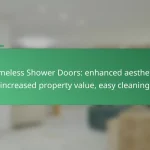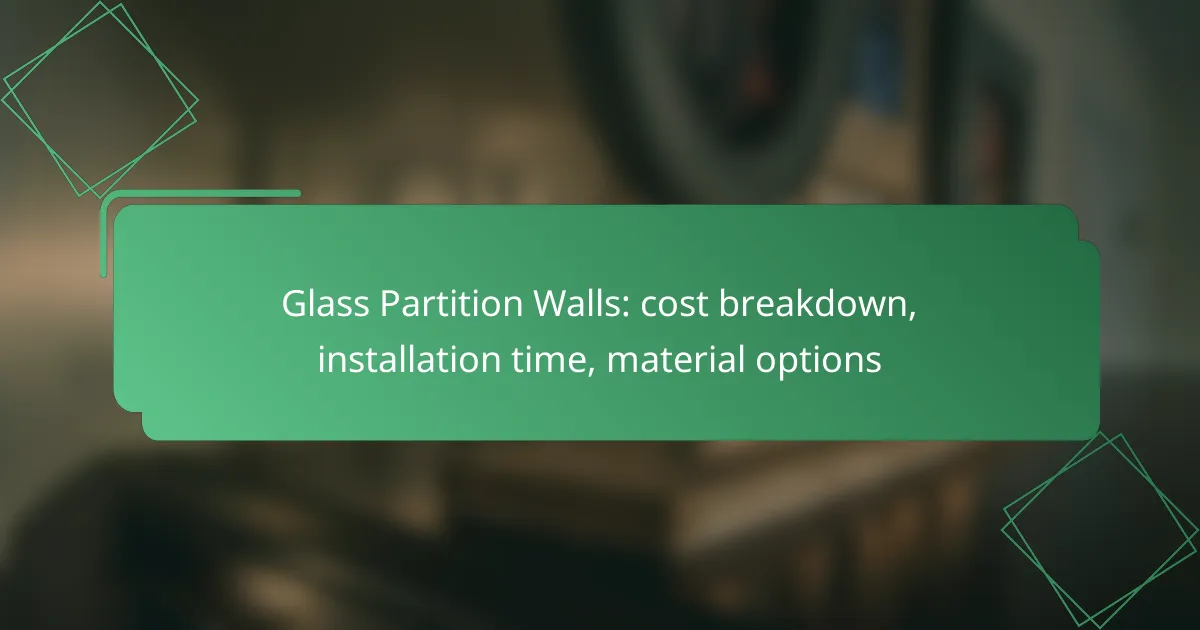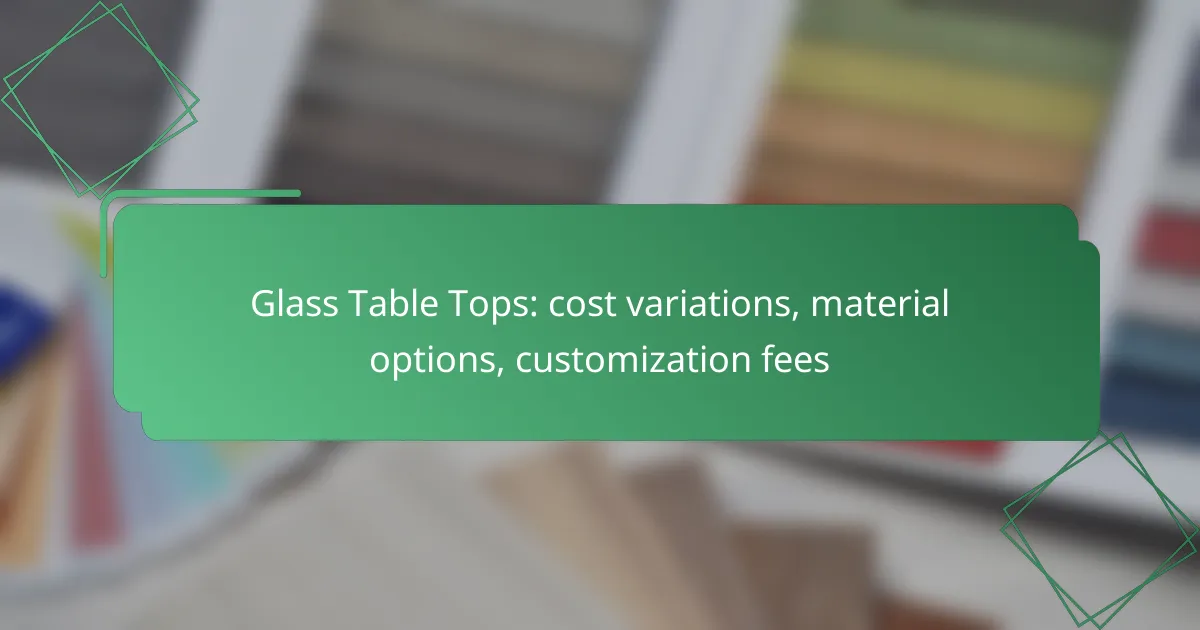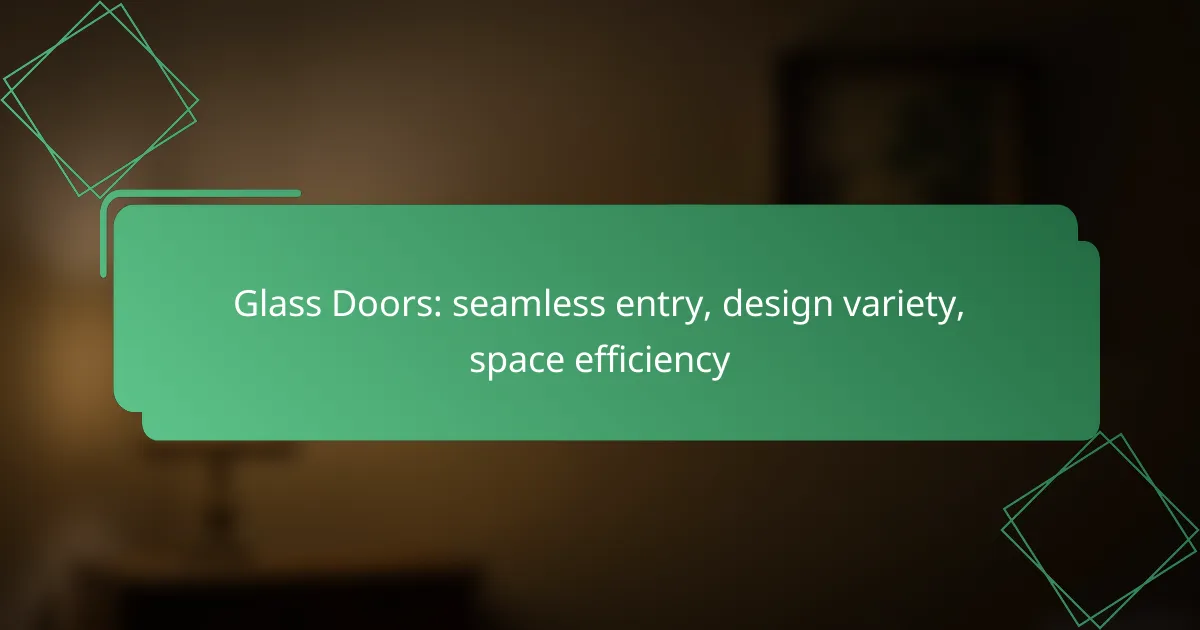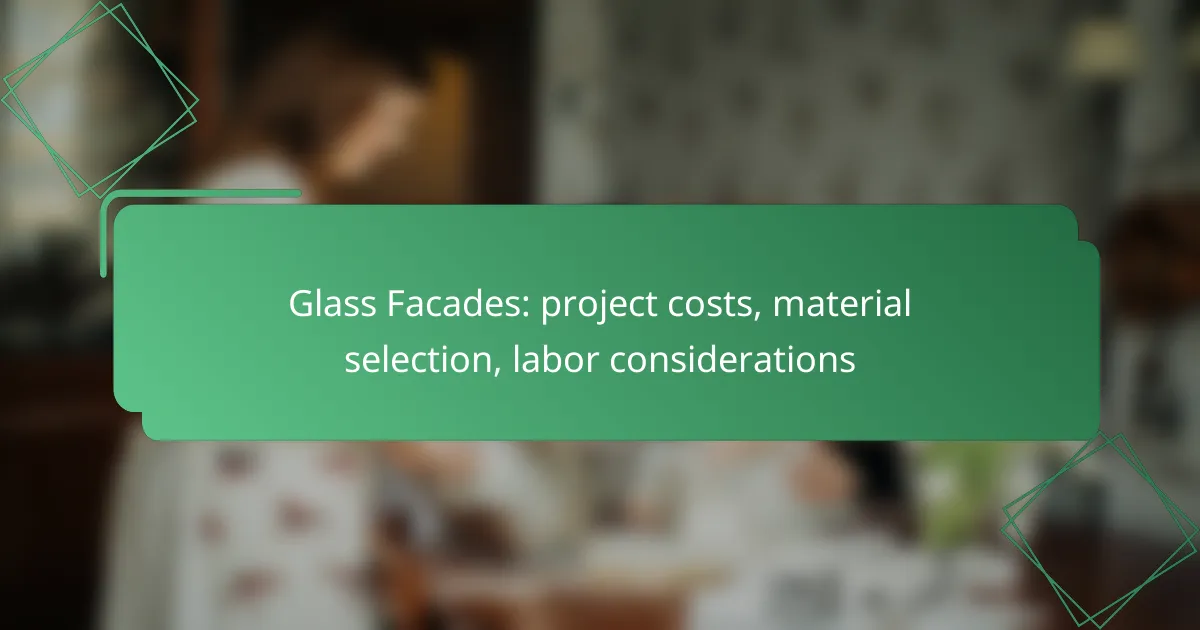Glass partition walls are an increasingly popular choice for both commercial and residential spaces, offering a modern aesthetic and functional versatility. The costs typically range from CAD 100 to CAD 300 per square foot, influenced by material choices and installation complexity. Installation can take anywhere from a few days to a week, depending on project specifics, while options such as frameless, framed, soundproof, and safety glass allow for tailored solutions to meet diverse design and functional needs.

What are the costs of glass partition walls in Canada?
The costs of glass partition walls in Canada typically range from CAD 100 to CAD 300 per square foot, depending on various factors such as materials and installation complexity. Understanding these costs can help businesses and homeowners make informed decisions when considering glass partitions for their spaces.
Average installation cost
The average installation cost for glass partition walls in Canada is generally between CAD 1,500 and CAD 5,000 for standard office setups. This price can vary based on the size of the project and the complexity of the installation process.
For larger installations or custom designs, costs can increase significantly, sometimes reaching CAD 10,000 or more. It’s advisable to obtain multiple quotes from contractors to ensure competitive pricing.
Material cost breakdown
Material costs for glass partition walls can vary widely based on the type of glass and framing used. Standard tempered glass typically costs between CAD 30 and CAD 70 per square foot, while laminated or specialized glass can range from CAD 70 to CAD 150 per square foot.
In addition to glass, framing materials such as aluminum or steel can add CAD 10 to CAD 30 per linear foot. Including hardware and installation accessories can further increase the overall material cost.
Labor costs
Labor costs for installing glass partition walls in Canada generally range from CAD 50 to CAD 100 per hour, depending on the contractor’s experience and the project’s complexity. Most installations take between 8 to 20 hours, depending on the size and number of walls being installed.
It’s essential to factor in these labor costs when budgeting for your project, as they can significantly impact the total expense. Hiring experienced professionals can help ensure a quality installation and avoid costly mistakes.
Factors affecting pricing
Location also plays a role; urban areas may have higher labor rates compared to rural regions. Additionally, any necessary permits or compliance with local building codes can add to the overall cost.
Cost comparison with drywall
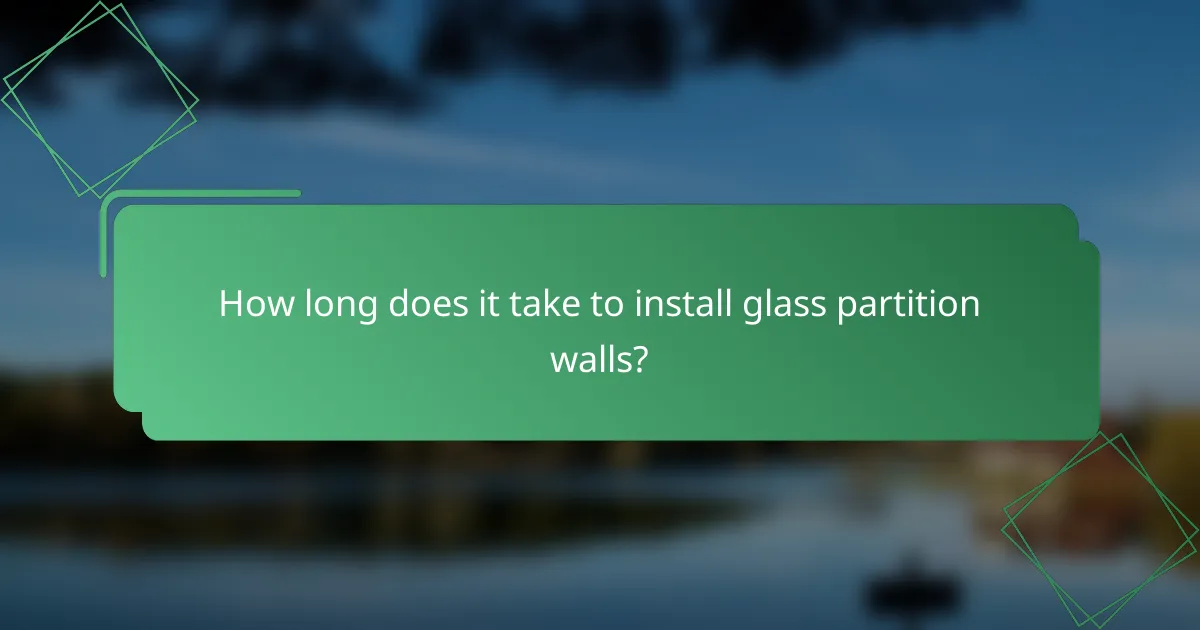
How long does it take to install glass partition walls?
The installation of glass partition walls typically takes a few days to a week, depending on the complexity of the project and the size of the space. Factors such as design, preparation, and the number of walls being installed can significantly influence the overall timeline.
Typical installation timeline
A standard installation of glass partition walls usually spans 3 to 7 days. This includes time for measuring, cutting, and fitting the glass panels, as well as any necessary finishing work. For larger projects or custom designs, the timeline may extend to two weeks or more.
Initial site preparation and the actual installation process are the two main phases of the timeline. Each phase can vary based on the specifics of the project and the availability of materials.
Factors influencing installation time
Weather conditions can also impact the installation, especially if outdoor work is involved. Lastly, any required permits or inspections can introduce delays, so it’s wise to account for these in the planning stages.
Preparation and planning duration
Preparation and planning for glass partition wall installation can take anywhere from a few days to several weeks. This phase includes site assessments, design consultations, and obtaining necessary permits. Proper planning is essential to ensure a smooth installation process.
During this time, it’s advisable to finalize design choices and confirm material availability. Engaging with a professional installer early can help streamline this phase and avoid potential setbacks during installation.
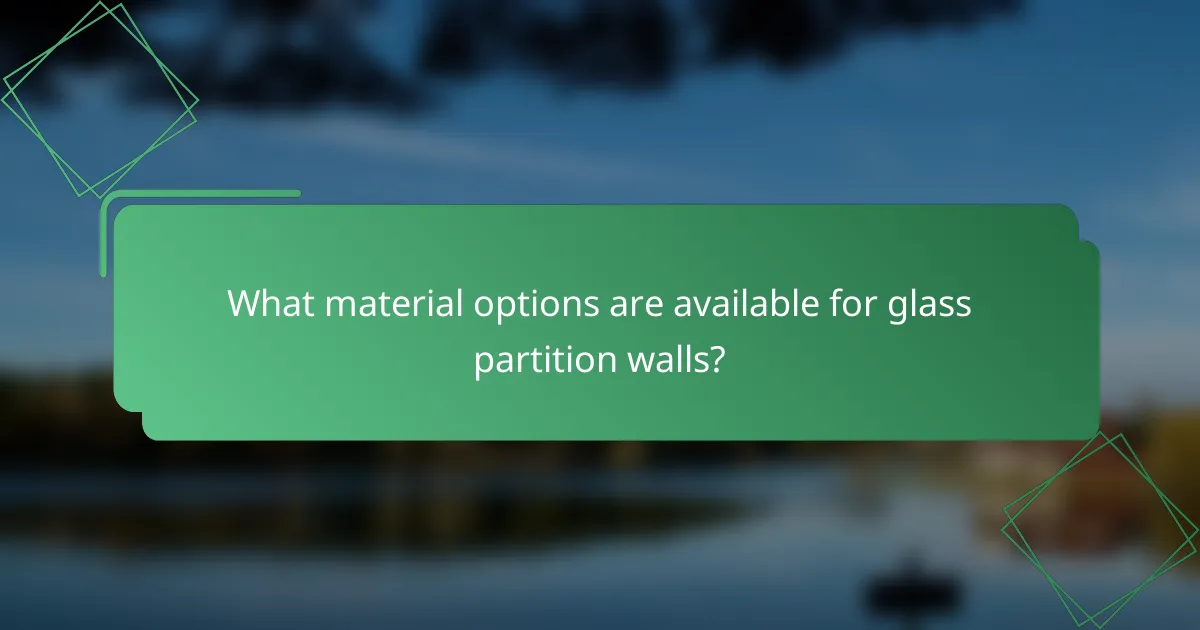
What material options are available for glass partition walls?
Glass partition walls come in various material options, each offering unique benefits and aesthetics. The main types include frameless, framed, soundproof, and safety glass, allowing for customization based on design preferences and functional needs.
Frameless glass options
Frameless glass partitions provide a sleek, modern look by eliminating visible frames, creating an open and airy feel. These options typically use tempered or laminated glass for strength and safety, making them suitable for both commercial and residential spaces.
When considering frameless glass, ensure proper installation to maintain structural integrity. It’s essential to account for the thickness of the glass, which usually ranges from 10 to 12 mm, to ensure durability and sound insulation.
Framed glass options
Framed glass partitions feature a visible frame, usually made from aluminum or steel, which can enhance stability and support larger glass panels. This option allows for more design flexibility, including various colors and finishes for the frame.
Framed partitions are often more cost-effective than frameless options and can be easier to install. They are ideal for environments where additional sound insulation or privacy is needed, as the frame can accommodate thicker glass panels.
Soundproof glass specifications
Soundproof glass partitions are designed to minimize noise transmission, making them ideal for offices or spaces requiring privacy. These partitions typically use laminated glass with an interlayer that absorbs sound, achieving sound reduction ratings between 30 to 50 decibels.
When selecting soundproof glass, consider the thickness and type of interlayer used, as these factors significantly influence performance. Ensure that the installation is airtight to maximize soundproofing effectiveness.
Safety glass types
Safety glass is essential for any glass partition wall, particularly in high-traffic or public areas. The two main types are tempered glass, which is heat-treated for strength, and laminated glass, which consists of two glass layers with a plastic interlayer that holds the pieces together if broken.
Using safety glass not only meets building codes but also enhances user safety. Always check local regulations regarding glass safety standards to ensure compliance in your installation.
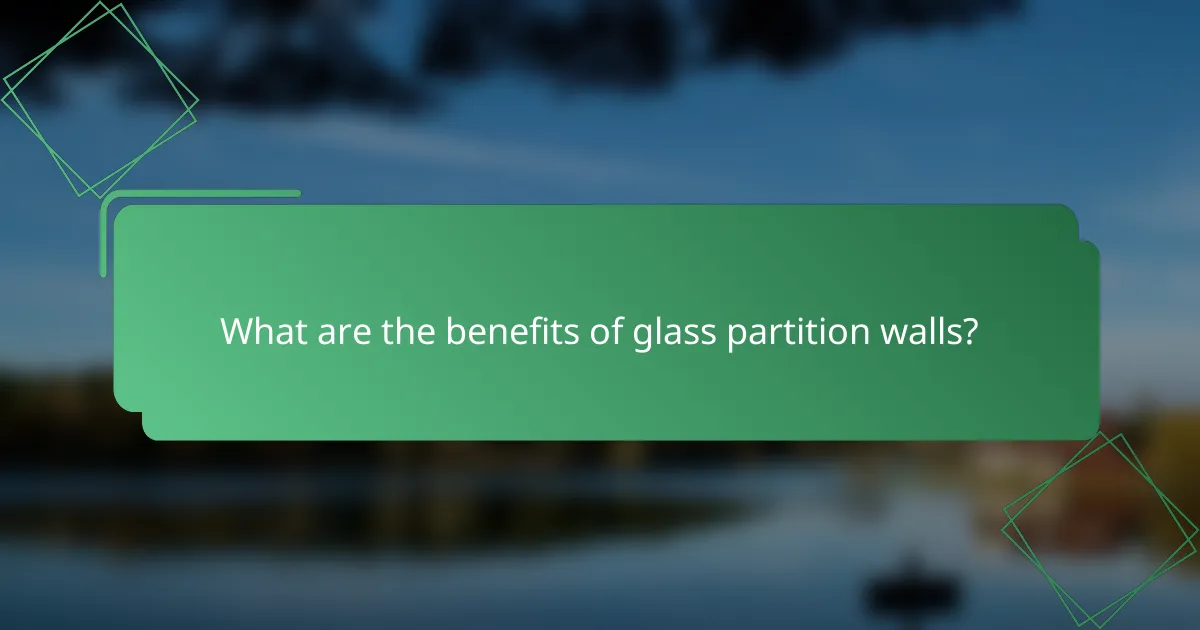
What are the benefits of glass partition walls?
Glass partition walls offer numerous advantages, including enhanced aesthetics, improved natural light flow, and increased flexibility in office layouts. These features contribute to a more open and inviting workspace, promoting productivity and collaboration.
Enhanced natural light
One of the primary benefits of glass partition walls is their ability to maximize natural light in a space. Unlike traditional solid walls, glass allows sunlight to penetrate deeper into the office, reducing the need for artificial lighting during the day.
Incorporating glass partitions can lead to energy savings, as they help maintain a well-lit environment without relying heavily on electricity. This can be particularly beneficial in regions with high energy costs, such as Western Europe or North America.
Space perception improvement
Glass partition walls can significantly alter the perception of space within an office. They create a sense of openness, making areas feel larger and less confined. This is especially advantageous in smaller offices where maximizing perceived space is crucial.
By using glass, businesses can maintain visual connections between different areas, fostering communication and collaboration among employees. This design choice can enhance the overall atmosphere, making it more conducive to teamwork.
Flexibility in office design
Glass partition walls provide remarkable flexibility in office design, allowing for easy reconfiguration as business needs change. Unlike permanent walls, glass partitions can be relocated or adjusted with minimal disruption, making them ideal for dynamic work environments.
Businesses can create various layouts, from open spaces to private offices, without extensive renovations. This adaptability is particularly useful for companies that anticipate growth or shifts in team structures, ensuring that the workspace evolves alongside the organization.

What are the installation requirements for glass partition walls?
Installing glass partition walls requires careful planning and adherence to specific guidelines. Key requirements include understanding local building codes, ensuring structural integrity, and selecting appropriate materials for the intended space.
Building codes in Canada
In Canada, building codes for glass partition walls vary by province and municipality. Generally, these codes dictate safety standards, fire resistance, and accessibility requirements. It’s essential to consult local regulations to ensure compliance and avoid costly modifications later.
For instance, some regions may require tempered or laminated glass for safety, while others might have specific height restrictions or guidelines for installation methods. Engaging with a local contractor familiar with these codes can streamline the process.
Structural considerations
When installing glass partition walls, structural considerations are crucial to ensure stability and safety. The walls must be anchored securely to the floor and ceiling, and the load-bearing capacity of existing structures should be assessed. This may involve consulting with a structural engineer.
Additionally, consider the thickness and type of glass used, as these factors impact both durability and sound insulation. Common options include single-pane and double-pane glass, with the latter offering better soundproofing. Always factor in the weight of the glass when planning the installation to ensure proper support.




